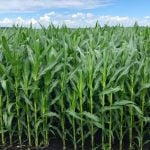In the past 10 years, growers across Canada have been introduced to a parade of specialty and alternative crops. East and west, there’s been camelina, crambe, sainfoin and, of course, quinoa — with test plots indicating it might be grown here with even better quality than in South America.
Black barley is among the newest of these new arrivals. Also referred to as Ethiopian black barley because of its country of origin, black barley was once an important food source for the ancient civilizations of North Africa, the Middle East and the Himalayas. Its name derives from the black colour of its edible gloom (i.e. bran) layer, which stays attached to the kernel.
Read Also

Could crop sharing be a viable option for your farm?
Crop sharing could be a good option for young and beginning farmers.
The grain itself is white, yet unlike most other hulled barley varieties which are fed to livestock, black barley is considered a hulless or “naked” type, and could see its greatest demand from specialty food markets seeking its reported nutritional and medicinal values.
Its North American history isn’t clear. One report says the crop was first raised by an American farmer in Montana. Another contends that it started with seed imported from Russia in 1911.
What is clearer, however, is that black barley is currently being grown in Arizona and California, although specific acreages aren’t available.
For Dr. Tarlok Singh Sahota at the Thunder Bay Agricultural Research Station (TBARS), 2014 is also the first year he’s been able to give black barley a fair chance in test plots. In 2013, seed from Woodland Foods in Waukegan, Illinois, arrived too late for optimal planting and the weather at the Lakehead remained relatively cool, so what did get planted in June didn’t mature very well.
This year, Sahota was delayed again by the prolonged winter, but he did manage to get the plots planted on May 23.
Balanced yields
“We found that it tillers profusely and has a pale green canopy,” says Sahota, the director of research and business at TBARS. “It’s nearly one month later to head compared to AC Newdale and at 96 cm in height, is eight cm (about three inches) taller than AC Newdale. But it’s also seven cm shorter than Millhouse.”
In addition to its tillering capability, black barley has shown test yields that are comparable to other barley varieties. According to an extension bulletin from the University of Vermont, field trials conducted in 2012 indicated grain yield from black barley was 58.3 bu./ac. On paper, this may not measure up compared 72.6 bu./ac. for AC Newdale and 59.8 bu./ac. for Robust. However, Sahota notes that both Newdale and Robust are hulled barley varieties, meaning their net grain yield after removing the hulls is closer to 48.8 bu./ac. for Newdale, and 40 bu./ac. for Robust.
Bushel weight is also higher in black barley at 54.4 lb., compared to AC Newdale at 46 lb. and Robust at 47 lb.
Another positive trait is its adaptability. Similar to conventional hulled varieties, black barley is expected to be as easy to grow near Palmerston or Winchester, Ont., or St. Hyacinthe, Que., as it is south of Thunder Bay.
The longer growing season in southern regions is another advantage. Weed control is also expected to be a simple matter, not only because the same chemistries that are used on feed barley apply to black varieties, but because of the thicker tillering in black barley varieties.
“There’s no room for weeds to grow,” says Sahota.
Preliminary indications are that disease control may be an issue, Sahota says, but it will depend on the specific area, the barley varieties grown there, and on the disease species particular to that area. “Each barley variety will be different in terms of susceptibility to a particular disease.”
The separation process also sets black barley apart from hulled barley production. When processed as a food source, barley hulls bind to the kernels and must be removed, usually with the loss of the bran layer. But with black barley being hulless, there is no separation stage; the hull simply falls off during combining, leaving the whole-grain kernel and the edible-bran layer intact.
A new food frontier
Black barley has a unique opportunity to tempt so-called “foodies,” many of whom are including quinoa in their diets. Black barley is touted as having a rich, nut-like flavour, and an appealing chewy, pasty-like texture, and has a glossy “sheen” to it when cooked.
When it comes to its uses, it can be eaten alone as a hot breakfast cereal or added to soups, stir fries, rice pilafs, grain salads and even stuffing. Ground into flour, black barley can be used to make bread, pancakes, pasta — anything that conventional wheat flours can be used to make.
From a health perspective, black barley is reported to be high in dietary fibre, minerals (including molybdenum, manganese, selenium, copper, phosphorus and magnesium), Vitamin B1 and niacin. It’s believed that niacin can help reduce total cholesterol and lipoprotein (a) levels. Its dietary fibre is high in beta glucan, which can also help lower cholesterol by binding to biliary acids and excreting them from the body.
According to work done at Agriculture and Agri-Food Canada’s Cereal Research Centre in Morden, Man., a quarter-cup of barley provides three grams of beta glucan per day, sufficient to reduce cholesterol and the risk of coronary heart disease and diabetes.
In concept, Sahota says, black varieties may therefore become barley’s equivalent to identity-preserved soybeans.
Barley’s chief current markets are for livestock feed and the brewing industry (although malting barley production is almost exclusive to Western Canada). That’s why Sahota maintains that black barley is a perfect fit for the specialty food market.
As consumers’ tastes and demands for different flavours and healthier food choices continue to grow, Sahota believes farmers may find this as a perfect opportunity to feed those demands.
















